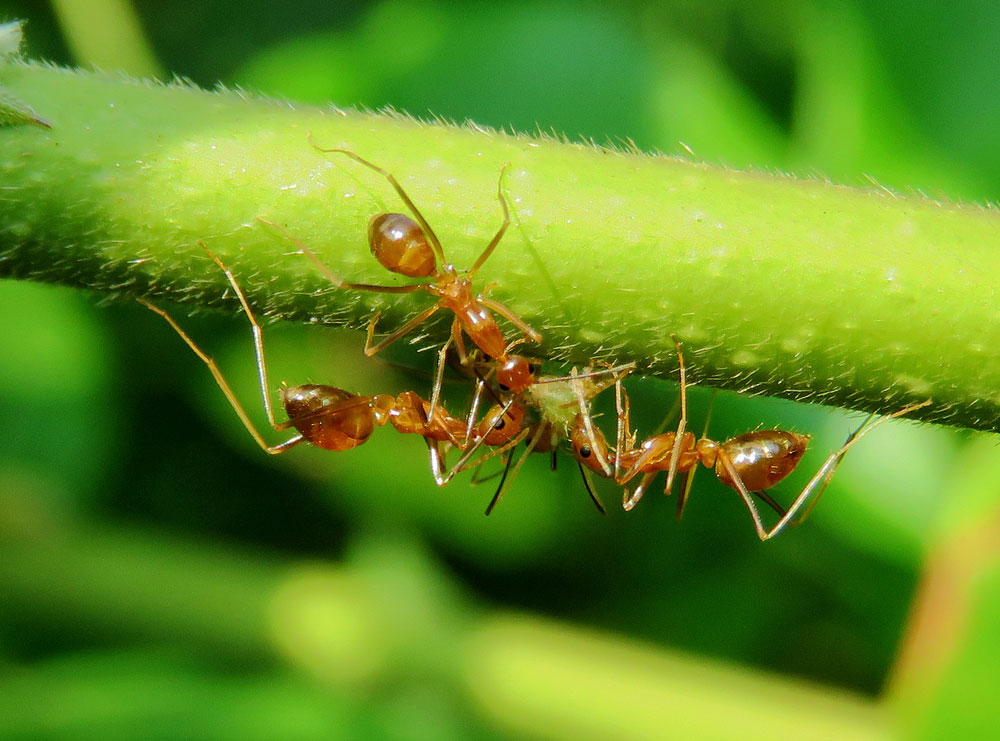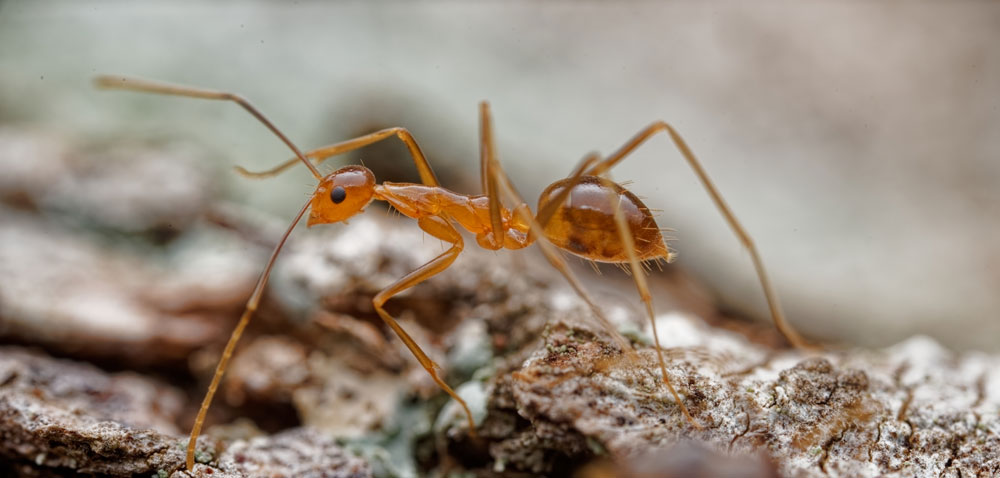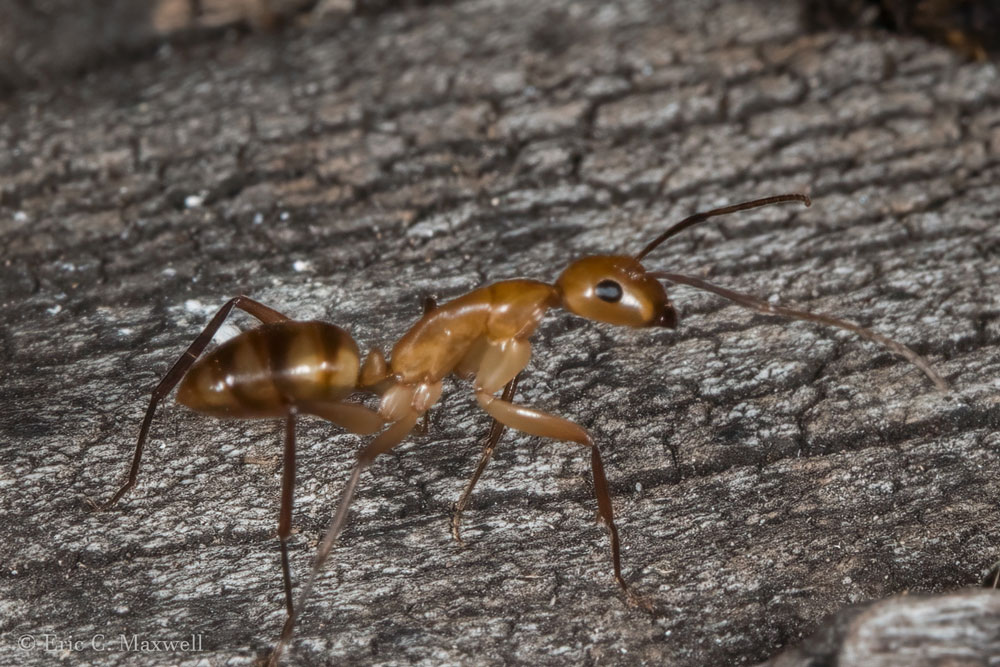
Yellow Crazy Ant
Anoplolepis gracilipes
Species Info General
Other common names include: Long-legged Ant
Hawaii has several unrelated species of “crazy” ants, the adjective referring to their habit of running extremely fast, usually in haphazard and changing directions with no obvious destination in mind. The Yellow Crazy Ant is a large, fast-moving and conspicuous ant common throughout Maui’s lowlands. It is particularly fond of rocky habitat such as what is found along streams, rocky beaches, rock walls and broken concrete slabs.
This ant is a serious pest, primarily impacting Hawaii’s native biodiversity but also quite annoying to the state’s human residents. Wetterer (2005) summed up this ant’s impacts this way: “Anoplolepis gracilipes commonly shows extreme population explosions and has direct negative impacts on many animals, both vertebrates and invertebrates. In addition to attacking hatchling birds and reptiles, A. gracilipes preys upon newborn pigs, dogs, cats, rabbits, rats, and chickens. In addition, A. gracilipes can be a significant agricultural pest, enhancing populations of phloem-feeding Hemiptera.” The population cycles Wetterer mentions, wherein it might seem nearly absent for years in a given location only to explode into apocalyptic numbers seemingly overnight, can be quite disconcerting. Still, this ant is unaggressive towards people: it does not sting and rarely bites, so the threat to humans is minimal. However, the ant can harm babies or bedridden adults whose ability to swat the ants by hand is compromised: this ant’s method of subduing prey is by ejecting a small bit of acid, and if enough ants apply enough acid on the skin of a hapless person or baby painful acid burns may develop over time. The bigger problem, however, is this ant’s ability to devastate our native fauna, from endangered damselflies to endemic happyface spiders to ground nesting seabirds who can suffer from severe acid burns on their soft, developing feet and beaks while they are still confined to the nest.

Unfortunately, controlling this ant is quite difficult. It does not respond to typical ant baits in any sort of consistent or predictable manner, and as a result population numbers often don’t seem to change despite heroic control efforts. A decade-long eradication program carried out recently by a consortium of agencies working on Johnston Atoll has moved us in the right direction in terms of increasing our knowledge and ability to control this species. However, more work needs to be done before easy solutions can be picked up off the shelf at the local hardware and garden store. Some research suggests that an Integrated Pest Management approach that includes targeted reduction of carbohydrate availability in the ant’s environment is likely going to be required. Fortunately, population explosions of this ant are typically followed by remarkable population crashes within a year or so, so to some extent the simplest solution is to just wait them out.



Identification/Description
Yellow Crazy Ants are one of the largest ants in the Islands. Up close they have a slim appearance with long antennae and long legs. Their coloring varies from yellowish to orange-ish red. The combination of their coloration, speed, size and aimlessness is pretty unique amongst Hawaii’s ant fauna. Our Carpenter Ants are somewhat similar: they are also large, slim and fast, but they usually appear in low to moderate numbers. The gaster (“butt”) of a Yellow Crazy Ant is usually unpatterned, while Carpenter Ants tend to have striped gasters. Also, Carpenter Ants are polymorphic: if you see a hundred of them you will likely notice that they come in a variety of sizes, while Yellow Crazy Ants are all one size.
Impacts
- Yellow Crazy Ants aggressively prey on native arthropods, interfering with the balance of predators, prey and pollinators in our native ecosystems.
- This species’ voracious predation on native arthropods is particularly thought to play a role in the decimation of endemic riparian arthropods including native damselflies.
- They promote the proliferation of aphids, scale, mealybugs and related species that often cause agricultural damage.
- At times they are a significant nuisance in yards and sometimes inside the home.
History
- Yellow Crazy Ants arrived in Hawaii in the 1940s. By the mid-1950s it was already “extremely abundant” in places on Oahu. It was found on Hawaii Island in 1954 and on Maui in 1968. By the end of the 1990s it had also invaded Molokai, Lanai and Kauai. In their 1993 paper, “The Effect of Alien Predatory Ants (Hymenoptera: Formicidae) on Hawaiian Endemic Spiders (Araneae: Tetragnathidae)”, Gillespie & Reimer described the devastating impacts of this ant on some of Hawaii’s iconic arthropod fauna.
Resources/References
- Maui Invasive Species Committee’s Brief Guide to Maui’s Ants – Anoplolepis gracilipes – AntWiki
- Abbott, K. L. 2005. Supercolonies of the invasive yellow crazy ant, Anoplolepis gracilipes, on
- an oceanic island: Forager activity patterns, density and biomass. Insectes Sociaux 52: 266-273.
- Gillespie, R. G. & Reimer, N. 1993. The Effect of Alien Predatory Ants (Hymenoptera:
- Formicidae) on Hawaiian Endemic Spiders (Araneae: Tetragnathidae). Pacific Science 47(1): 21–33.
- Hoffmann, B. D., Auina, S. & Stanley, M. C. 2014. Targeted Research to Improve Invasive
- Species Management: Yellow Crazy Ant Anoplolepis gracilipes in Samoa. PLOS One 9(4)(e95301): 1–10.
- Wetterer, J. K. 2005. Worldwide Distribution and Potential Spread of the Long-Legged Ant, Anoplolepis gracilipes (Hymenoptera: Formicidae). Sociobiology45(1): 1–21.
